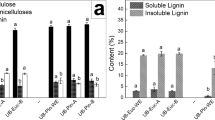Abstract
Fiber properties (fiber swelling ability, crystal structure of cellulose, fiber surface morphology, and etc.) of eucalyptus kraft pulp with different contents of carboxyl group in Na-form were studied. There was a direct proportional relationship between water retention value and carboxyl content of pulp. When the carboxyl content increased from 35.6 to 315.7 mmol/kg, tensile index and burst index increased by 56.1 and 117.8 %, respectively, and crystallinity of cellulose decreased by 11.8 %. Environmental scanning electron microscope showed that more fibrillation was observed on the carboxymethylated fiber surface, compared with the control sample. The results from Fourier transform infrared spectra analysis suggested that the relative intensity of the band at 1,633/cm was increased after carboxymethylation treatment, which showed that the carboxyl content increased. The increase in the carboxyl content not only could increase the fiber strength properties, but also could increase the recycling times of the fiber.




Similar content being viewed by others
References
Ahrens F, Karrila S, Jeyaseelan R (2000) Investigation and improvements of the modified water retention value test. AICheE Annual Meeting, AICheE Press, Los Angeles, CA
Barzyk D, Page DH, Ragauskas A (1997) Acid group topochemistry and fibre-to-fibre specific bond strength. J Pulp Pap Sci 23(2):59–61
Bertoniere NR, King WD (1989) Effect of scouring/bleaching, caustic mercerization, and liquid ammonia treatment on the pore structure of cotton textile fibres. Text Res J 59:114–121
Bhardwaj NK, Duong TD, Nguyen KL (2004) Pulp charge determination by different methods: effects of beating/refining. Colloids Surf A Physicochem Eng Asp 236:39–44
Borsa J, Reicher J, Rusznhk I (1992) Studies of the structural aspects of carboxymethylcellulose of low degree of substitution. Cellul Chem Technol 26(3):261–275
Chen YM, Wang Y, Wan JQ, Ma YW (2010) Crystal and pore structure of wheat straw cellulose fiber during recycling. Cellulose 17(2):329–338
Chen YM, Wan JQ, Huang MZ, Ma YW, Wang Y, Lv HL, Yang J (2011) Influence of drying temperature and duration on fiber properties of unbleached wheat straw pulp. Carbohydr Polym 85(4):759–764
Engstrand P, Sjögren B, ölander L (1991) The significance of carboxylic groups for the physical properties of mechanical pulp fibers. In: Proceedings 6th international symposium wood pul** chemistry, pp 75–79
Grignon J, Scallan AM (1980) Effect of pH and neutral salts upon the swelling of cellulose gels. J Appl Polym Sci 25(12):2829–2843
Huang YG, He BH, **ao P, Liang JW, Chen XQ (2001) The method and mechanism to delay the quality decay of recycled plant fibers. Pap Sci Technol 20(5):14–17
Katz S, Scallan AM (1983) Ozone and caustic soda treatments of mechanical pulp. Tappi J 66(1):85–87
Katz S, Beatson RP, Scallan AM (1981) Mechanism for the alkali strengthening of mechanical pulps. Tappi J 64(7):97–100
Korpela A (2002) Improving the strength of PGW pine pulp by alkaline peroxide treatment. Nord Pulp Pap Res J 17(2):183–186
Laine J, Lindström T, GladNordmark G (2002) Studies on topochemical modification of cellulosic fibres. Part 2. The effect of carboxymethyl cellulose attachment on fibre swelling and paper strength. Nord Pulp Pap Res J 17(1):50–56
Lindström T, Carlsson G (1982) The effect of carboxyl groups and their ionic form drying on the hornification of cellulose fibers. Sven Papp 85(16):146–151
Lu J, Shi SL, Yang RN, Niu MH, Song WJ (2005) Modification of reed cellulose microstructure and IT change in enzymatic hydrolysis of reed pulp. Trans Chin Pulp Pap 20(2):85–90
Mitikka-Eklund M, Halttunen M, Melander M (1999) Fibre engineering. In: 10th international symposium on wood and pul** chemistry, Yokohama, Japan, 1, pp 432–439
Nakamura K, Hatakeyama T, Hatakeyama H (1981) Studies on bound water of cellulose by differential scanning calorimetry. Text Res J 51:607–613
Nelson ML, Kalkisakis CG (1964) The carboxymethylation of a eucalypt kraft pulp. Tappi 47:107–110
Pan GX (2004) Relationship between dissolution of fiber materials and development of pulp strength in alkaline peroxide bleaching of mechanical pulp. Holzforschung 58(4):369–374
Pavlov P, Makaztchieva V, Lozanov E (1992) High reactivity of cellulose after high-temperature mercerization. Cellul Chem Technol 26(2):151–160
Rácz I, Borsa J (1997) Swelling of carboxymethylated cellulose fibers. Cellulose 4:293–303
Rácz I, Borsa J, Bodor G (1996) Crystallinity and accessibility of fibrous carboxymethylcellulose by pad-roll technology. J Appl Polym Sci 62:2015–2024
Rebuzzi F, Evtuguin DV (2006) Effect of glucuronoxylan on the hornification of eucalyptus globules bleached pulps. Macromol Symp 232:121–128
Scallan AM (1983) The effect of acidic groups on the swelling of pulps: a review. Tappi 66:73–75
Scallan AM, Grignon J (1979) The effect of cations on pulp and paper properties. Sven Papp 82(2):40–47
Shi SL, He FW (2006) Analysis and detection of pulp and paper. China Light Industry Press, Bei**g
Warwicker JO, Jeffries R, Colbran RL, Robinson RN (1985) Cellulose chemistry and its application. In: Nevell TP, Zeronian SH (eds) Wiley, New York, p 164
Xu QH, Qin MH, Shi SL, ** LQ, Fu YJ (2006) Structural changes in lignin during the deinking of old newsprint with laccase–violuric acid system. Enzym Microb Technol 39:969–975
Zhang Y, Sjögren B, Engstrand P (1994) Determination of charged groups in mechanical pulp fibers and their influence on pulp properties. J Wood Chem Technol 14(1):83–102
Acknowledgments
This work was supported by China Postdoctoral Science Foundation (2013M542177, 2013T60807), the National Natural Science Foundation of China (Nos. 31170551 and 31200458), the Ph. D. Program Foundation of Ministry of Education of China (No. 20110172110015), the Foundation for Distinguished Young Talents in Higher Education of Guangdong, China (No. LYM10014) and the Fundamental Research Funds for the Central Universities, SCUT (2013ZZ0031, 2012ZZ0050).
Author information
Authors and Affiliations
Corresponding author
Rights and permissions
About this article
Cite this article
Chen, Y., Wan, J., Dong, X. et al. Fiber properties of eucalyptus kraft pulp with different carboxyl group contents. Cellulose 20, 2839–2846 (2013). https://doi.org/10.1007/s10570-013-0055-8
Received:
Accepted:
Published:
Issue Date:
DOI: https://doi.org/10.1007/s10570-013-0055-8




